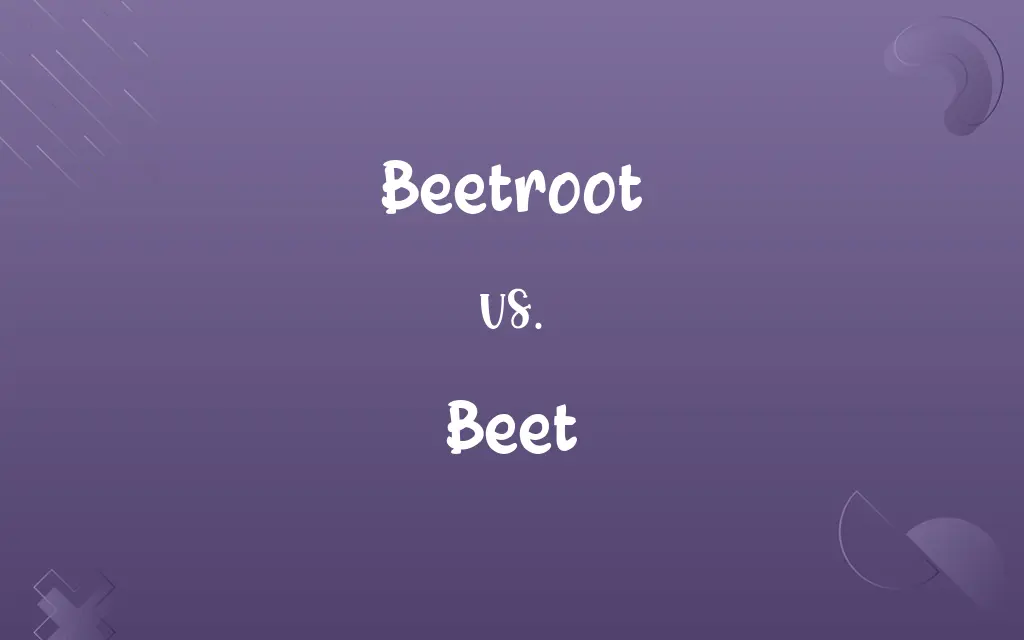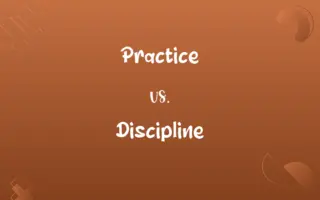Beetroot vs. Beet: Know the Difference

By Shumaila Saeed || Updated on December 26, 2023
Beetroot specifically refers to the purple root vegetable, part of the beet plant, while beet can refer to the entire plant including its root, leaves, and stems.

Key Differences
Beetroot is commonly known for its deep purple color and is a specific part of the beet plant, primarily consumed as a root vegetable. Beet, in a broader sense, encompasses the whole plant, including beetroot, beet greens, and stems.
Shumaila Saeed
Dec 26, 2023
In culinary terms, beetroot is often used in salads, soups, and as a cooked vegetable, celebrated for its sweet, earthy flavor. Beet can refer to any culinary use of the plant, including the leaves, which are similar to spinach in taste and texture.
Shumaila Saeed
Dec 26, 2023
Nutritionally, beetroot is rich in fiber, vitamins, and minerals, particularly known for its high nitrate content. When speaking of beet, it refers to the nutritional values of the entire plant, including the health benefits of its greens.
Shumaila Saeed
Dec 26, 2023
In cultural contexts, beetroot is often more prominently featured in European and Australian cuisines, known for dishes like borscht. Beet in the American context might refer more generally to both the root and the greens, used in a variety of dishes.
Shumaila Saeed
Dec 26, 2023
In gardening and agriculture, beetroot specifically refers to the cultivation of the root portion of the plant. Beet, however, can refer to the cultivation practices for the entire plant, including the selection of varieties that might be grown for their roots, leaves, or both.
Shumaila Saeed
Dec 26, 2023
ADVERTISEMENT
Comparison Chart
Part of Plant
Refers to the root portion of the beet plant
Refers to the entire plant
Shumaila Saeed
Dec 26, 2023
Culinary Usage
Used in dishes like salads and borscht
Includes use of leaves, stems, and root
Shumaila Saeed
Dec 26, 2023
Nutritional Content
High in fiber, vitamins, and nitrates
Encompasses nutritional values of whole plant
Shumaila Saeed
Dec 26, 2023
Cultural Significance
Prominent in European cuisine
Used broadly in various cuisines
Shumaila Saeed
Dec 26, 2023
Agricultural Focus
Cultivated for the root
Cultivated for root, leaves, or both
Shumaila Saeed
Dec 26, 2023
ADVERTISEMENT
Beetroot and Beet Definitions
Beetroot
A dark purple root vegetable.
She added sliced beetroot to the salad.
Shumaila Saeed
Dec 26, 2023
Beet
Cultivated for its edible roots and leaves.
The farmer harvests beets for the local market.
Shumaila Saeed
Dec 26, 2023
Beetroot
Used as a natural food coloring.
Beetroot juice gave the cake a vibrant hue.
Shumaila Saeed
Dec 26, 2023
Beetroot
Often pickled or roasted in cooking.
Roasted beetroot enhances the flavor.
Shumaila Saeed
Dec 26, 2023
ADVERTISEMENT
Beet
Leaves of the beet plant, eaten as greens.
Beet greens are nutritious and tasty.
Shumaila Saeed
Dec 26, 2023
Beetroot
Consumed for its health benefits.
Beetroot is known for improving blood flow.
Shumaila Saeed
Dec 26, 2023
Beet
Includes various types like sugar beets.
Sugar beets are processed for sugar extraction.
Shumaila Saeed
Dec 26, 2023
Beet
A biennial Eurasian plant (Beta vulgaris) grown as a crop plant for its edible roots and leaves.
Shumaila Saeed
Oct 19, 2023
Beetroot
A normally deep-red-coloured root vegetable usually cooked or pickled before eating; beet.
Shumaila Saeed
Oct 19, 2023
Beet
The swollen root of this plant eaten as a vegetable, typically having reddish flesh.
Shumaila Saeed
Oct 19, 2023
Beet
Beta vulgaris, a plant with a swollen root which is eaten or used to make sugar.
The beet is a hardy species.
There are beets growing over these.
Shumaila Saeed
Oct 19, 2023
Beetroot
Beet having a massively swollen red root; widely grown for human consumption
Shumaila Saeed
Oct 19, 2023
Beetroot
A key ingredient in borscht.
Beetroot gives borscht its characteristic color.
Shumaila Saeed
Dec 26, 2023
Beet
A biennial plant of the genus Beta, which produces an edible root the first year and seed the second year.
Shumaila Saeed
Oct 19, 2023
Beet
The root of plants of the genus Beta, different species and varieties of which are used for the table, for feeding stock, or in making sugar.
Shumaila Saeed
Oct 19, 2023
Beet
Biennial Eurasian plant usually having a swollen edible root; widely cultivated as a food crop
Shumaila Saeed
Oct 19, 2023
Beet
Used in both savory and sweet dishes.
She made a beet salad with oranges.
Shumaila Saeed
Dec 26, 2023
Repeatedly Asked Queries
Is beetroot the same as red beet?
Yes, red beet is another term for beetroot.
Shumaila Saeed
Dec 26, 2023
What is beetroot commonly used for?
Primarily as a root vegetable in various dishes.
Shumaila Saeed
Dec 26, 2023
Are beetroot leaves edible?
Beetroot refers to the root; the leaves are part of the beet plant.
Shumaila Saeed
Dec 26, 2023
Do beets come in colors other than purple?
Yes, beets can be red, yellow, or even striped.
Shumaila Saeed
Dec 26, 2023
What's the nutritional difference between beetroot and beet?
Beetroot is high in fiber and nitrates, while beet includes the nutrients of the entire plant.
Shumaila Saeed
Dec 26, 2023
Is the sugar beet a type of beet?
Yes, it's a variety grown for sugar production.
Shumaila Saeed
Dec 26, 2023
What's the best way to store beetroot?
In a cool, dry place or refrigerated.
Shumaila Saeed
Dec 26, 2023
What does 'beet' refer to in gardening?
It refers to the entire beet plant.
Shumaila Saeed
Dec 26, 2023
Are beets used in desserts?
Yes, especially in sweetened forms like beetroot cake.
Shumaila Saeed
Dec 26, 2023
Are beetroot and beet interchangeable in recipes?
Not always, as beetroot specifically refers to the root.
Shumaila Saeed
Dec 26, 2023
Can beets be grown in a home garden?
Yes, they are a popular garden vegetable.
Shumaila Saeed
Dec 26, 2023
Share this page
Link for your blog / website
HTML
Link to share via messenger
About Author
Written by
Shumaila SaeedShumaila Saeed, an expert content creator with 6 years of experience, specializes in distilling complex topics into easily digestible comparisons, shining a light on the nuances that both inform and educate readers with clarity and accuracy.









































































